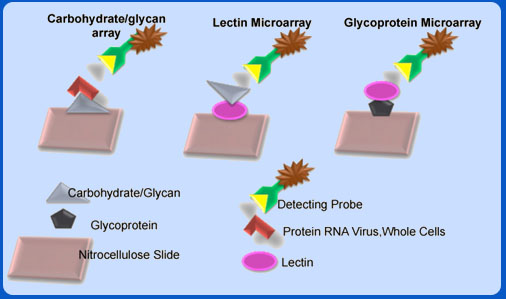The concept and methodology of microarrays were in use as early as the 1980s. It was first introduced and illustrated in antibody microarrays (also as antibody matrix). Microarrays gain notable when DNA microarrays emerged as an exciting new biomolecular tool capable of probing the entire transcriptome of the cell in the mid of the 1990s. Nowadays, microarrays have been widespread across genomic research and can apply to a diverse range of applications in biology and medicine field.
Microarray is a two-dimensional multiplex lab-on-a-chip. It is arranged by the immobilization of molecules in discrete spatial locations, normally on a high density and solid substrate (typically a glass slide or silicon thin-film cell). Depending on the nature of the molecule immobilized on the physical substrate, there are different types of microarrays, such as DNA, protein, glycan, small molecule, cell, or even tissues. DNA microarrays are used to measure gene activity and genotyping and to study comparative genomics. Protein microarrays are employed to profile protein expression, to investigate various types of protein interactions and to characterize functional properties. Antibody microarrays detect antigens and protein expression and have a wide range of diagnostic applications. Cellular microarrays can be used to detect reverse transfection and PMHC and to study cell responses. Tissue microarrays are used to compare histologic sections from unique tissues or tumors and to compare tissues from multiple patients on the same slide. There are also carbohydrate microarrays to study the interactions of bacteria cell with carbohydrates and to detect pathogens. Additional types of microarrays include chemical compound microarray, phenotype microarray, reverse phase protein microarray, and many more specific types under development. For glycosylation studies different types of microarrays such as carbohydrate array, lectin arrays, glycoprotein arrays and other array formats have been used.
 Figure 1. Different types of microarray platforms for glycosylation studies
Figure 1. Different types of microarray platforms for glycosylation studies
The unprecedented capacity is available to simultaneously interrogate multiple immobilized probes and apply to a large amount of biological material using high-throughput multiplex detection methods. The microarray offers several prominent advantages, including miniaturization and parallelization. It is a collection of microscopic feature which can be probed with target molecules to produce either quantitative or qualitative data.
As one of the leading companies in the omics field with over years of experience in omics study, Creative Proteomics provides offers a variety types of glycan-related microarray assays.
- Lectin Microarray Assay
- Glyco-gene Microarray Assay
- Glycan Microarray Assay
- Microbial Glycan Microarray Assay
- Glycopeptide Microarray Assay
How to place an order



















